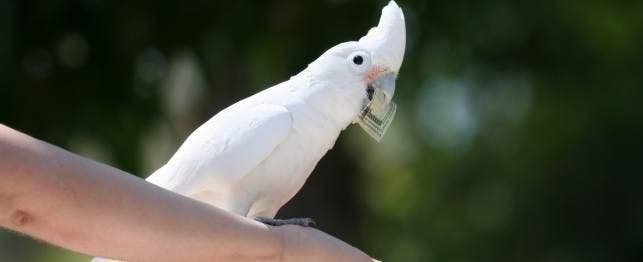- by FPABS-Admin
- 0
- Posted on
Goffin’s Cockatoo

Goffin’s cockatoos also known as the Tanimbar cockatoo – are active, high-energy birds. They are gentle, playful and very affectionate – in short, they make excellent family pets. They need a lot of attention, but are not as demanding or possessive as white cockatoos. However, they are not very common in the United States.
Appearance and Personality
These birds have short white crests and blue eye rings with a small pink patch between the eyes and nares (nostrils). They may be confuse with the larger bare-eye cockatoo. The flight feathers on the underside are yellow.
The formal scientific name for the bird is Cacatua goffini. In the wild, they inhabit coastal lowland forests and woodlands on the Tanimbar Islands of Indonesia. They also invade cultivated areas and damage crops, gathering in flocks of 300 or more birds and feeding on seeds, crops, fruits, berries, buds, flowers, nuts and insect larvae. They are most active in early morning and late afternoon.
Goffin’s cockatoos can live up to 40 years. Precise data on the life span of the average Goffin’s cockatoo is poorly documented. Many die of disease or injury well short of their potential life span.
Goffin’s cockatoos are inquisitive and love to chew objects in their surroundings, but they are not as destructive as other cockatoos. They should always be provided with toys, blocks of wood or branches to chew on. To avoid fear of new situations, young cockatoos should be socialize to many people and expose to a variety of situations such as new cages, toys and visits to the veterinarian. The birds make good pets for young families.
Grooming
Routine bathing or showering is vital to maintaining good plumage and skin condition. Birds can be miste and allow to dry in a warm room or in the sun, or gently dried with a blow drier. Care should be take not to clip the wing feathers excessively as cockatoos often fall and injure themselves. Clip only the primary flight feathers and only enough so the bird will glide to the floor. Goffin’s is better flyers than Moluccans and umbrellas, and a few more feathers should be removed than is customary with those species.
Feeding
Cockatoos should be fed a pellet diet. High-protein diets make an excellent staple diet for cockatoos. Weaning food can also be use. The diet should be supplement with fresh fruits and vegetables daily to add variety. Feed approximately 1/4 cup of formulate diet and 1/4 cup of fresh fruits and vegetables daily. Monitor the bird’s food intake. Overfeeding leads to pickiness, selective feeding and wasteful throwing of food.
Goffin’s cockatoos are picky eaters that utilize calories efficiently. Try to ensure that the food they eat is nutritious and avoid feeding large quantities of high-fat sunflower and safflower seeds. Vitamin supplements are not need for birds on a formulated diet.
Housing
Goffin’s cockatoos are very active and should be provided the largest cage that space and budget allows. Ideally, the cage should provide room for flight, but at a minimum, it must allow space for the bird to fully spread his wings.
Durable cage construction is not as critical for Goffin’s as it is for large cockatoos because they are not such strong chewers. Many are adept at opening cage latches, however, so locks or escape-proof latches may be necessary. Ideally, the bird should also have an outdoor cage to allow playtime in the fresh-air and sunlight.
Breeding
Goffin’s cockatoos can be difficult to breed in captivity. Wild-caught pairs may take years to adapt and become reliable breeders. Breeding age can be as young as 2 years, but due to difficulty in adaptation of first generation birds, few captive birds are being bred. Breeding life span is not precisely known.
Male cockatoos frequently become aggressive toward their mates. Cage construction should take into consideration techniques to reduce mate aggression. Clipping the wings of the male prior to the breeding season will help the female to escape in case the male becomes aggressive. Aggressive behavior may occur in compatible breeding pairs.
Double-entrance boxes are often use to reduce the chance of the male trapping the female in the nest box. Wooden boxes can be use.Goffins tend to like a deep, narrow nest. Size should be approximately 12 inches by 12 inches by 36 inches or deeper.
Incubation period is approximately 24 to 26 days. Chicks usually fledge at approximately 8 to 10 weeks of age. Goffin’s cockatoos are relatively easy to hand-rear; most hand rearing formulas can be use successfully.
Goffin’s cockatoos are not as noisy as the larger cockatoos. When breeding any cockatoos, however, noise and proximity to neighbors must be consider. If housed outdoors, cockatoos often call at night – especially during a full moon. In southern states, outdoor caging must be protect from opossums to prevent exposure to the parasite Sarcocystis falcatula, which can result in a fatal lung infection.
